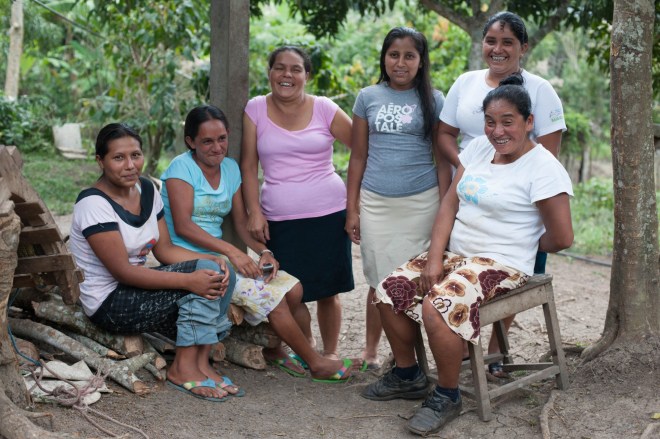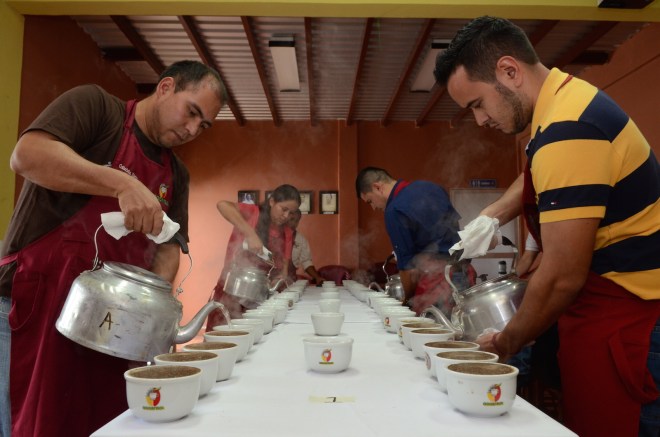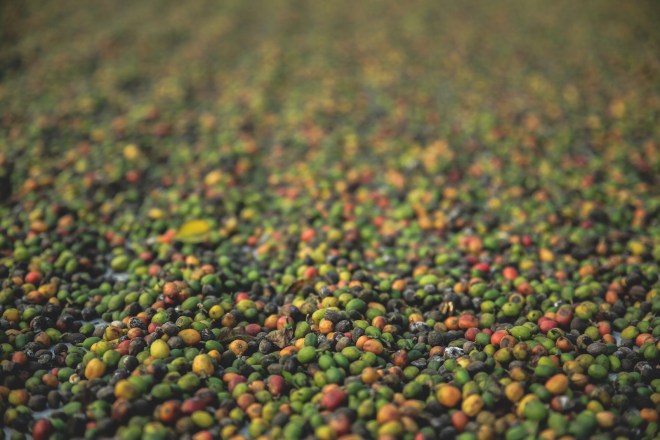One day in 1994, Jorge Cuevas found himself in the rural highlands of Oaxaca Mexico, sweating on a wooden bench among rows of coffee farmers in 100-degree heat. They sat together in silent anticipation, looking down at their hands and feet, awaiting a verdict that would determine not only the quality of their lives for the coming months, but the welfare of their families and all who depended on them.
Cuevas was recruited by a cooperative of indigenous coffee farmers in southern Mexico to help them acquire a USDA Organic certification. They knew that the certification, while costly, could boost purchase prices for their beans and help them climb out of poverty. For most of the farmers, coffee was their lifeblood, yet they had essentially no input in the valuing of their crop.
Inside the building before them, which they had constructed to please and accommodate their visitors, three men from a distant and unimaginably different world sat in the air conditioning drinking cold beverages, and determining the fates of the farmers outside. Just as a Roman emperor would signal the fate of a gladiator with an upturned or downturned thumb, the traders would eventually emerge from their laboratory and signal to the farmers their conclusion. Thumbs up: Yes, the coffee meets our standards and we will buy it. A celebration among the farmers usually ensues. Thumbs down: The coffee does not meet expectations. It will not be bought.
At last the traders emerged, two blonde men, each a head taller than the tallest farmer present. The farmers held their breath and for a moment the only thing that could be heard was the hum of insects and birds. The men held out their fists, thumbs pointed up. The farmers erupted in celebration immediately, though they hadn’t yet learned the price they would be paid.
A small fiesta followed. Bottles of tequila exchanged hands. When the fiesta died down, the two traders waved goodbye and stepped into their large air-conditioned SUV that would take them to a nearby resort before they flew home in the morning. Cuevas watched as farmers packed into the back of two large trucks, squeezing 20 to 30 of them into each flatbed. A three-hour drive through bumpy mountain roads awaited them, but under their sombreros they wore irrepressible smiles. Despite the palpable joy of the farmers as they shuttled away, Cuevas could not shake the feeling that there was injustice underlying the scene around him.
Today, Cuevas is the chief coffee officer at Sustainable Harvest, a raw coffee trading company that connects farmers in the developing world with roasters in the United States. In more than two decades working in the coffee industry, Cuevas has seen coffee make its way across borders and around the globe through many different pathways – but almost all are unknown to either the consumers or the producers. These opaque supply chains leave farmers with little control over their market. They often end up taking low prices, which force them to use environmentally damaging farming practices, and leave them trapped in poverty.
Cuevas is trying to change this by forging simplified supply chains. The coffee industry calls this direct trade, whereby roasters buy directly from farmers instead of using the usual middlemen. The result, say direct trade proponents, is better prices for farmers and better coffee for consumers. It is growing in popularity, but some observers warn that the acclaim has not yet been earned.
Leveling the playing field

Women of Las Hermanas.Sustainable Harvest
If you are paying more than $14 for a 12-ounce bag of coffee, there is a good chance that the words “direct trade” are written somewhere on it. The words might even be portrayed like a certification stamp, the same way Fair Trade or USDA Organic labels are. Unlike those certification programs, “direct trade” includes no strict definition, no managing body, and no enforcement mechanism. Instead, direct trade is based on the premise that the most ethically produced and traded coffee will be reached by introducing the buyers to the producers. Give the farmers a chance to participate in the trading of their coffee, the reasoning goes, and a mutually beneficial system will emerge.
Years after his experience with the coffee cooperative in Oaxaca, Cuevas visited a woman-run cooperative, Las Hermanas, in the highlands of Nicaragua. After a long journey on winding dirt roads to the remote cooperative, Cuevas arrived at an evaluation lab and met four evaluators. Instead of unknown traders from half a world away, these were the sons and daughters of the farmers whose coffee they were tasting, with certifications from the same quality evaluation system that would later be used again later to evaluate the coffee in the country of sale. Knowing the quality of their own coffee gives farmers significantly more leverage in setting prices. And, when farmers understand the quality evaluation system — instead of just being told “yes” or “no” by a trader — it allows them make improvements. “The farmers know not only whether they have achieved the right quality but they also know why,” says Cuevas. The evaluators can help determine “what it is missing, and how to improve. Is it processing, handling, pruning? Now they have the information needed to improve.”
Direct trade attempts to address the problems of the coffee industry in a much different way than regulated certifications: by eliminating steps in the supply chain rather than adding new ones.
The supply chains for coffee are often long and complicated. Every link in that chain — everyone along the way — gets a cut of the price you pay for a cup of coffee or bag of beans. Farmers are left with a miniscule share of the final purchase price. In the end, farmers are invisible and underpaid.
How direct trade can give farmers more clout

A quality control coffee cupping at the Cocafelol cooperative in Honduras.Sustainable Harvest
Direct trade, when done correctly, forges a relationship between roaster and producer, and that one benefit alone can drastically alter the trading dynamic. In Santa Cruz, Calif., the roasting company Verve sources coffee from around the world with an emphasis on developing relationships with their producers. Seventy to 80 percent of their coffee they call “farm level,” their own name for direct trade.
Jesse Crouse, who worked at Verve until June 2015, used to work out the logistics of every raw coffee bean purchase at Verve, whether that meant flying to Colombia to negotiate with a farmer or sampling the newest featured beans from an importer. Crouse is just 29, but talks about coffee with the urgency and severity of a man who has spent decades in the industry.
“What companies have done in the past is they would go to an importer and say ‘I want a coffee with these characteristics, do you have something like this?’” If the importer does have something that fits, Crouse says, “They would give the roaster three sentences about the coffee, something like, ‘This is from Guatemala. This is its quality level. It costs this and it tastes like this.’”
Direct trade removes the telephone-game transfer of information and replaces it with one-to-one communication. This simple change can have an incredible impact on the producer.
Two years ago, while on a sourcing trip in Central America, Crouse tasted a coffee that, while not amazing, was good enough to spark his interest, and he decided to visit. The farm was called La Mina, and it was high in the mountains of Honduras. It was beautiful, and for coffee, high elevation generally means higher quality. La Mina was a little more than six acres, owned by Rodrigo Erazo, who had always sold his coffee to traders at the standard low commodity prices.
It did not take long for the Verve team to figure out how to improve Erazo’s coffee: Among the varieties of coffee being produced at La Mina was a crop of Robusta coffee trees, which produce very low quality beans. Because Erazo had always traded his coffee to anonymous buyers, it never made sense for him to separate his coffee by variety. After removing the Robusta beans, the coffee from La Mina scored incredibly high by quality testers, and Crouse bought everything Erazo produced that year for a price three times greater than anything ever sold from La Mina. That same year, Erazo was able to buy new drying beds for his coffee and install electricity in his home, a luxury he could never afford before.
What about Fair Trade?

Freshly picked coffee cherries await processing in Antigua, Guatemala.Lucas Oliver Oswald
The plight of coffee farmers first came to wide public attention during the 1990s. A new wave of consumerism sought to find ways to enjoy coffee without the guilt and discomfort of contributing to a corrupt system. Fair Trade certification was supposed to be the solution, but some research suggests that the benefits to farmers are sometimes outweighed by the costs. A study from University of Wisconsin in 2012 showed that Fair Trade certification could add to the production costs significantly while reducing yields. Another study from University of California in 2012 showed that the average cost per pound to the producer for a Fair Trade certification is sometimes greater than the price benefit.
With little to no disposable income, small farmers face a tradeoff between crucial farming inputs like fertilizers or extra labor and a Fair Trade certification. Assessing Fair Trade as a success or failure is complicated, but much of the evidence tilts toward the former.
Criticisms aside, Fair Trade and other regulated certifications like it are getting one crucial thing right: consistency. Because Fair Trade is presided over by a specific organization, it does not vary. It consistently delivers what it promises: when you buy Fair Trade certified coffee, you can be sure that the farmer has the benefit of a price floor, and that work is being done to ensure that laborers are being paid fair wages. This universal assurance of standards is what direct trade lacks.
“People may or may not agree with the guidelines or impacts of a certification, but it is consistent,” says Cuevas, “Direct trade is not. Your version of direct trade may be different from my version, which may be different from Blue Bottle’s or Counter Culture’s. Direct trade has no centralized, cohesive set of standards.”
According to Cuevas, instead of a standardized set of rules and regulations, direct trade operates under the principles of “empowerment, transparency, open information, and the willingness to have equitable trade relationships.” This may sound idealistic, and it is. But underlying this idealism is the simple human truth that it is much harder to take advantage of someone after shaking his or her hand.
Some researchers are skeptical. “My biggest concern with many of these initiatives is this question of rural democracy,” said Christopher Bacon, an assistant professor in environmental studies and sciences at Santa Clara University, who has done research on coffee farmers in Nicaragua for the past 15 years, studying how farming practices have affected their wellbeing and food security.
“Sometimes it’s easier to form a direct relationship with a large farm, and sometimes these large farms have relations that promote worker empowerment but often times it’s just a step away from a feudal setup and the hacienda plantation model persists.”
In other words, direct trade will just be another force aiding the trade of coffee from large plantations with potentially contemptible labor practices, rather than helping the small farmers.
In the rural and underdeveloped regions that produce coffee, the large producers often dominate the local market and access to trade. As a coffee roaster from the U.S. trying to make a connection with a farmer in the highlands of Guatemala, it is a lot easier to find, contact, and meet farmers who have a website and email address than one who might not even have electricity or a paved road to their farm. If direct trade fails to connect roasters with the smaller coffee producers, then it poses the risk of giving large producers an advantage that could lead to further inequality among the farmers.
On the other hand, there is the potential economic advantage of a streamlined supply chain, even if it only reaches the largest farms at first. Once roasters have a foot in the communities that produce their beans, they have the opportunity to drive down those unpaved roads and meet those farmers without electricity or websites. Because there is competition among the elite roasters for an ever-better bean, roasters may find themselves searching beyond the easy trade routes to discover smaller farmers.
Additionally, roasters and importers can influence farms. When they have a direct relationship with a farm, roasters are more likely to ask producers to meet their standards rather than simply find another farmer.
“Now, often direct trade relationship [partners] come first and inquire about getting the [Fair Trade] certification,” said Bacon. “In some cases, they even help pay for the certifications.”
How well travelled is your coffee roaster?

Jorge Cuevas (center) in the Sustainable Harvest quality control room.Lucas Oliver Oswald
As a researcher, Bacon deals in data, and he says there’s not enough data to judge direct trade. The biggest danger is that any roaster can claim that their coffee is directly traded. Within the industry there’s a growing fear that the words “direct trade” could become as meaningless as “All Natural” or “Green.”
Cuevas of Sustainable Harvest says there is a rule of thumb that can reveal the validity of a claim. “Next time a roaster tells you about their great direct trade program, ask them about their passport,” he says. If it is not full of visas and stamps, the roaster is not personally meeting and negotiating with producers.
Coffee is plagued by an opaque supply system. Consumers can change that by demanding coffee that is still connected to its empowered producer. Ask for a story about the farmer who produced your coffee. If you can find one, odds are that story will be a good one.



